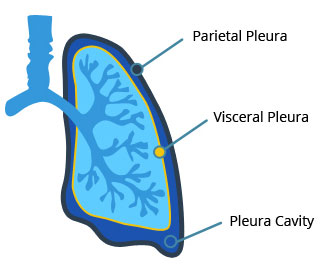Pleural Mesothelioma
 Pleural mesothelioma is a form cancer that is almost always caused by asbestos exposure and is most commonly found in the outer lining of the lungs called the mesothelium. This is the most common type of asbestos related cancers and has been studied to a far greater degree than any of the other forms of the disease. The vast majority of treatment options and all of the staging guidelines currently utilized in its diagnosis are based on the pleural cancer, and it is mostly assumed to be this disease when people speak of “mesothelioma.” Peritoneal mesothelioma accounts for the majority of other diagnoses. Although ongoing research is being conducted to find a cure, or cures, for all types of the disease, they are all still considered to be incurable in the medical community.
Pleural mesothelioma is a form cancer that is almost always caused by asbestos exposure and is most commonly found in the outer lining of the lungs called the mesothelium. This is the most common type of asbestos related cancers and has been studied to a far greater degree than any of the other forms of the disease. The vast majority of treatment options and all of the staging guidelines currently utilized in its diagnosis are based on the pleural cancer, and it is mostly assumed to be this disease when people speak of “mesothelioma.” Peritoneal mesothelioma accounts for the majority of other diagnoses. Although ongoing research is being conducted to find a cure, or cures, for all types of the disease, they are all still considered to be incurable in the medical community.
Function of the Pleura
Pleural mesothelioma occurs when one of the pleura in the chest cavity becomes malignant. The pleurae are serous membranes, which mean they secrete a lubricating fluid, called serous fluid. There are two pleurae in the chest cavity and their job is to protect and cushion the lungs by secreting fluid that allows the lungs to move smoothly within the chest cavity when breathing. While they certainly serve an important purpose, each pleura can be removed if it becomes damaged or diseased. The ease of which it can be removed is dependent on which of the pleural surfaces becomes malignant: the parietal pleura or the visceral pleura. The parietal pleura lines the inside of the chest and covers the ribs and the pericardium. It is a fairly thin tissue between two and three millimeters thick and is the more easily removed of the two pleural surfaces. At a single millimeter in thickness, the visceral pleura is barely half the width of the parietal pleura. It directly covers the lung itself, which makes extraction of the visceral pleura without subsequent damage to the lung very difficult.
Development of Pleural Mesothelioma
While science has conclusively shown that mesothelioma is caused only by asbestos exposure, the actual biological processes by which it develops are still being investigated. In essence though, pleural mesothelioma develops when jagged asbestos fibers are inhaled and settle in and around the lungs. The fibers become lodged in its small passageways and in the surface of its lining. The body’s immune system is able to process and breakdown some of these asbestos fibers, but invariably many still remain. Over time, the fibers cause chronic inflammation, the development of pleural fibrosis (a thickening of the pleural surfaces) and pleural effusions (buildup of fluid in the pleural spaces) and in many people, cancerous cell development. If the fibers create a malignancy in the lung itself, one is diagnosed with lung cancer. If the malignancy begins in one of the pleural tissues, one is diagnosed with pleural mesothelioma. It is because of the proximity of the pleurae to the lung that many people mistake the disease for lung cancer. While a pleural malignancy can invade the lung itself, the tumor’s origin site is still the pleura, so pleural mesothelioma should never be treated as lung cancer. To learn more about the differences between the two cancers, please read: mesothelioma and lung cancer.
Symptoms and Diagnosis of Pleural Mesothelioma
Some of the most common symptoms of pleural mesothelioma are shortness of breath caused by excess fluid buildup in the pleural spaces, i.e., pleural effusions, and the loss of elasticity in the lungs due to tumor invasion. However, it is difficult to diagnose the cancer in its early stages because its symptoms often mimic the symptoms of other common illnesses, such as the flu, pneumonia or laryngitis. Some of the more common symptoms include:
- Chest pain (most common symptom)
- Coughing
- Wheezing
- Shortness of breath
- Fluid around the lungs (pleural effusion)
- Hoarseness or difficulty speaking
- Blood clots (less common)
Because of these similarities, as well as the relative rarity of asbestos related cancers in the general population, the disease is not always diagnosed and often grows untreated for many months. More precise and invasive diagnostic techniques, such as a tissue biopsy, are not often used until the symptoms become more pronounced. Thus, when a diagnosis is finally made, the cancer is often quite advanced. This could mean that multiple tumors have already invaded the pleural surfaces, have spread to the lymph nodes and/or have metastasized to other parts of the body, such as the lungs, heart, or abdomen. To learn more about the symptoms, please read: mesothelioma symptoms. To learn more about the diagnosis, please read: mesothelioma diagnosis.
Treatment and Prognosis of Pleural Mesothelioma
While pleural mesothelioma does not have a cure, treatments for cancers from asbestos are improving, as is our knowledge of the disease. Studies of patients with pleural mesothelioma show that important prognostic factors include the stage of the cancer, the age and health of the patient, and the histological subtype of the disease. As with any cancer, the overall health of the patient has a dramatic effect on one’s prognosis. Younger, healthier people are able to tolerate a more radical treatment regimen than those of advanced age or who are suffering from other ailments. An early diagnosis also improves a person’s prognosis.
The histological subtype is the most important prognostic factor impacting treatment. Epithelial mesothelioma is the most common form of the disease—regardless of the location of its origin site—and also presents with the best prognosis. Sarcomatoid is the least common form and presents with the worst prognosis. The biphasic subtype, as a mixture of the previous two subtypes, is considered a middle-of-the-road prognosis. The primary treatments, like all other forms of cancer, include surgery, chemotherapy and radiation. As a diffuse disorder, mesothelioma presents as an invasion of a large number of smaller masses throughout an entire area. This diffuse nature has important implications for how the cancer is treated, as complete surgical extraction of the cancerous tissue is difficult. Surgery, however, often improves the lifespan of the patient, even though it does not cure the disease. The most common surgical techniques used are pleurectomy/decortication and extrapleural pneumonectomy (EPP).
For patients treated with surgery, factors associated with improved long-term survival include epithelial histology, negative lymph node involvement (meaning the cancer has not spread into the lymphatic system), and negative surgical margins (meaning all visible tumors were removed after surgery). Nodal status is an especially important prognostic factor because it identifies the degree to which the cancer is spreading through the body. Negative lymph node involvement would mean the best prognosis, while local node involvement would be preferable to distant node involvement. Studies have shown the median survival of patients with malignant pleural mesothelioma is 16 months.
Other treatment options include chemotherapy and radiation. In 2004, the FDA approved the use of Alimta® with a platinum agent, such as cisplatin or carboplatin, for the treatment of pleural mesothelioma. This was the first time the FDA approved a chemotherapy regimen specifically for mesothelioma and this treatment has helped many patients. The United Kingdom has approved this combination as well. Radiation hasn’t proven to be as individually effective as surgery and chemotherapy have for the treatment, but is still an option that many doctors will use in combination with the other treatments. In fact, the most effective treatment regimen for pleural mesothelioma is known as multi-modal therapy, where two or three of these treatment modalities will be used to attack the malignancies in a variety of ways.
While advancements are being made in the treatment of the disease, especially with chemotherapy and surgery, the treatments are often only life-extending or palliative, which means the treatments can’t cure the disease but can relieve the symptoms of the disease, make the patient more comfortable and improve the patient’s quality of life during the months ahead. Many doctors feel that we are learning more information about mesothelioma treatments. While all doctors still acknowledge that a cure has yet to be found, understanding of the disease is rapidly progressing and treatments are improving.


